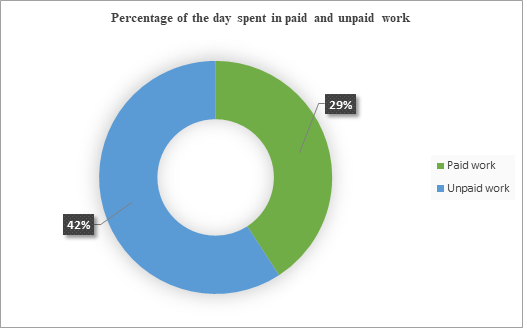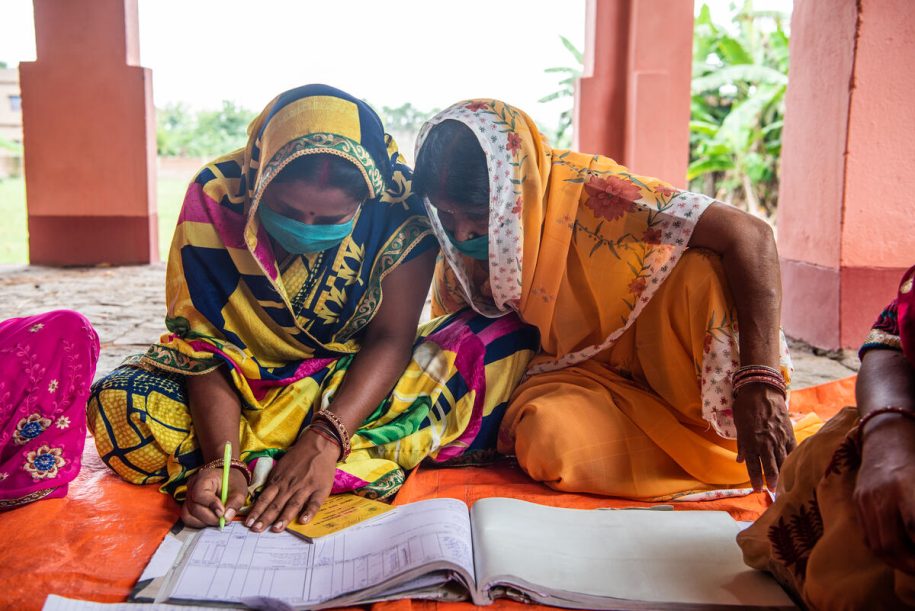Building on the evidence highlighted in the first part of this two-part blog, the discussion in this second piece is anchored in a normative framework that shapes individual and household-level decision-making processes governing “appropriate” jobs for rural women. These norms do not only organize the time-use of female labor between paid and unpaid work but provide a rationale for the Haqdarshikas to lean heavily on their families and self-help group (SHG) colleagues for submitting citizens’ applications without being away from home for unacceptable periods of time. To re-iterate the scope of activities under the Haqdarshak livelihoods model, consenting women from SHGs in Chhattisgarh were trained (as Haqdarshikas) in a mobile application (Haqdarshak) that they use to enroll citizens into welfare programs for a service fee.
This blogpost drives home the point that conceptualizing livelihoods models as solely capacity building programs to “unlock” women’s agency can bring only limited benefits. This is because such programs do not challenge or alter the structural impediments (e.g., norms of household duties that regulate women’s mobility for work) that constrain women’s capacities for agency. The piece concludes with a set of policy recommendations that can minimize the impact of these institutional constraints on women’s participation in paid work.
Norms Matter: Women’s Work and Ability for Agency
The norms governing “appropriate” jobs for rural women are manifest in the interviewee narratives of our Haqdarshikas (n=52, as on August 31, 2021). Haqdarshikas reflected on how the community-based nature of the livelihoods program was critical in gaining approval of their families to act on their motivation for paid work.
“I joined the [Haqdarshak] training to earn some more money, to get benefits of government schemes… I was also informed that we can do this work along with our existing work. I discussed it first with my family that I am working for Bihan [State Rural Livelihoods Mission or SRLM in Chhattisgarh] and for this work [enrolling citizens and submitting applications] I have to go here and there, so if you people are going to allow me to do it then only I will say yes. [Interviewee NC 27]
The flexibility in conducting door-to-door enrollment of citizens during her SHG activities, or filling out applications at home, whilst being present for household chores and care work means that a large portion of her paid work as a Haqdarshika can be accomplished within the time constraints defined by the larger socio-normative environment.
The findings from our survey with 1618 Haqdarshikas resonate with the primacy of family support in women’s participation in paid work. While 65 percent of the respondents disagreed with the statement that a man should be the only breadwinner in the family, more than 75 percent reported that their decision to work was made jointly with their husbands and other family members.
One could argue that women residing in joint or extended families – co-living with parents-in-law, grandparents, family of elder brother-in-law can face disproportionate pressures on the duration of time they can spend on work outside home (Debnath, 2015; Dhanaraj and Mahambare, 2019). That, indeed, holds in our case, though there is an over-representation of Haqdarshikas belonging to joint families (i.e., average of 6 members per household) in the survey and interviews.
However, a countervailing effect of a joint family set-up also exists where we find some evidence of in-laws offering support in household and care work while the Haqdarshikas are away for work. We also find some evidence of a weaker normative penalty on the mobility of unmarried women – comprising just 10 percent of the interviewee sample – to undertake labor and time-intensive activities as Haqdarshikas. Arguably, unmarried women living at home with their extended family may be more vocal and influential in shaping households’ decisions in support of work-outside-home.
“I am getting full support of my family… and I don’t have to do much of household work. My mother, sister, and sister-in-law are at home so I don’t have to do anything. I only help a little…when I want” [Interviewee NC 7]
Under what conditions and for how long these arrangements of co-sharing household responsibilities with other family members – mainly older women – may be relied upon by the Haqdarshikas for continuous engagement in Haqdarshak activities requires deeper qualitative engagement in the field over time.
Norms Matter for Networks
By regulating their mobility outside home, the norms that designate primary caregiving and household maintenance roles to women can impact the diversity and frequency of social engagements that Haqdarshikas can participate in with other grassroots workers (e.g., business correspondents) and key stakeholders (e.g., operators of kiosks for citizens’ services) for faster submission of welfare applications. The infographics below summarize the time-use patterns of Haqdarshikas in our interview sample. Between paid work outside and unpaid work inside homes, the near absence of unconstrained or residual time in their daily routine underscores the salience of social networks that women can potentially benefit from by minimizing the time and cost expenditures for Haqdarshika activities: [1]


The survey did not ask about leisure time.
All the interviewed Haqdarshikas reported leaning on their SHG colleagues for problem-solving vis-à-vis filling application forms, and collaborative support in submitting these forms at the relevant frontline agency. The existence of diverse social networks matters more when, for example, it allows a Haqdarshika to track the status of the applications and/or re-submit in case of errors, by just calling the kiosk operator with whom she has developed a good working relationship (revealed in the interviews with 11 Haqdarshikas) [2]. This informal mechanism of grievance redressal can, in principle, reduce delays in the receipt of entitled benefits by citizens, improve a Haqdarshika’s credibility, and subsequently encourage more people in the community to seek her support in making welfare applications.
Policy Recommendations: It’s the Institutions, Silly!
To make the Haqdarshak model a more accessible livelihoods program for rural women who may have fewer opportunities to develop deep and diverse networks with key officials and other agents outside their village, the institutionalization of Haqdarshikas as a cadre (that guarantees a monthly income) will be a necessary first step. Now, the Chhattisgarh State Rural Livelihoods Mission (CG-SRLM) already has a cadre known as Sakriya Mahila (Active Woman)/Community Resource Persons (CRPs) whose work profile somewhat complements a Haqdarshika’s activities: to mobilize rural women to form SHGs, disseminate information on welfare programs, and promote livelihoods activities in their villages. For these activities, Active Women/CRPs receive a monthly income of INR 1500 (approximately USD 20) from the government. However, these cadres of women have not been provided the tools to execute the mandate of community wellbeing entrusted to them.
We recommend that a Haqdarshika is seen as a counterpart of these community cadres, wherein the former has been trained to achieve the objectives of the latter. Paid work (and more pay-for-more-work) can signal value of women’s labor that, in turn, can create the space for re-negotiating gendered norms of household and care work that don’t land on the shoulders of other women at home. Between June 1, 2019 to July 31, 2021, close to 2700 Haqdarshikas have generated average annual revenue of INR 21,83,823 (approximately USD 29,511) for the government via application fees. And yet, despite a Haqdarshika contributing an average of INR 809 (approximately USD 11) to government coffers via fees for application forms, per annum, the Haqdarshak MIS shows that 1,900 of the Haqdarshikas made at least one application for free.
That is, the citizens paid only the government fee component (i.e., cost of the application form), and the Haqdarshikas made out-of-pocket payments to submit citizens’ applications. Therefore, a cadre will not just provide the necessary monetary support for these women to bring more citizens under the social safety net, but fairly compensate these women for their effort and the costs incurred [3]. This can be an important step towards: (i) supporting women’s (paid) participation in the workforce; and (ii) recognizing that women’s engagement in village-based activities that improve community welfare should not be seen as an extension of her welfare-improving unpaid work at home.
Once the Haqdarshikas become a cadre, they can be given unique login IDs that would allow them to submit citizens’ applications directly on to government service delivery platforms like mCHOICE in Chhattisgarh. Allowing Haqdarshikas to submit applications directly on to the government portal can minimize the time and monetary expenditures of visiting many different government departments and CSCs (Common Service Centres) that may not be conveniently located. In this sense, Haqdarshikas can be seen as “mobile CSCs”, akin to the business correspondents of public and private banks (called bank mitras in Chhattisgarh).
To further ease the burden on working women like Haqdarshikas, the state government can adopt the following two functionalities from the Haqdarshak app into its mCHOICE mobile application that is connected to the e-district portal: (i) self-screening by citizens to determine eligibility for welfare programs; (ii) clear and complete information on application submission procedures. This technological reform can do more than just achieve time-and-cost efficiency for Haqdarshikas. It can rectify informational asymmetries borne by citizens, promote administrative transparency, and minimize what governments may be worried about — fraudulent welfare claims by ineligible citizens.
In sum, the government will need to be more receptive to the varied ways in which welfare enrollments and livelihoods programs that improve community wellbeing can be promoted and achieved through more comprehensive, transparent, and efficient means. Further, Haqdarshikas’ labor needs to be seen as having economic value that can be a countervailing force against the dominant patriarchal values which depress women’s participation in the laborforce.
Endnotes
[1] About one percent of the women sampled in our study (24 survey respondents and 3 interviewees) reported Haqdarshika work as their primary (and sometimes, the only) paid job. Over 80 percent were office-bearers in their SHG networks (e.g., president, secretary, and book-keeper). The rest were self-employed in family enterprises, including agriculture, or worked as casual laborers in agriculture and public works (MGNREGA).
[2] Interviewees NC 16, NC 18, OC 1, OC 2, OC 5, OC 10, OC 13, OC 14, OC 16, OC 17, OC 23.
[3] These fees were earned from about 200,000 citizens who filed more than 300,000 applications. As of July 31, 2019, benefits had been received for 68 percent of the submissions made by the Haqdarshikas. The rest are under-process at different government departments.
References
Debnath, S. (2015). The impact of household structure on female autonomy in developing countries. The Journal of Development Studies, 51(5), 485-503.
https://www.tandfonline.com/doi/abs/10.1080/00220388.2014.983909?journalCode=fjds20 (last accessed December 6, 2021)
Dhanaraj, S. & Mahambare, V. (2019). Family structure, education and women’s employment in rural India. World Development, 115, 17-29.
https://www.sciencedirect.com/science/article/abs/pii/S0305750X18304029 (last accessed December 6, 2021)
National Rural Livelihoods Mission (2015). Framework for Implementation. Ministry of Rural Development, Government of India.
https://aajeevika.gov.in/sites/default/files/nrlp_repository/nrlm-framework-for-implementation.pdf (last accessed September 20, 2021)
Image: ©Gates Archive/Saumya Khandelwal
This article was first published on the Evidence Consortium on Women’s Group Blog. Read the original piece here.
About the Author
Tanushree Bhan is a Research Fellow with the Financial Inclusion vertical at LEAD. She graduated with a PhD in Public Policy from the University of Massachusetts, Boston in 2020. Her dissertation was a process-based evaluation of sanitation policy for the urban poor in Delhi. Tanushree has an undergraduate degree from the University of Delhi and a Master’s degree from the University of Mumbai, both in Economics. Before her PhD, Tanushree worked at the Indian Council for Research on International Economic Relations (ICRIER) until 2014.





